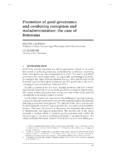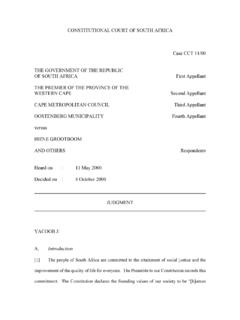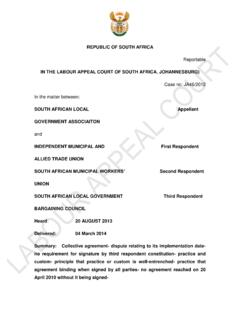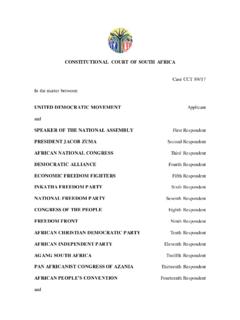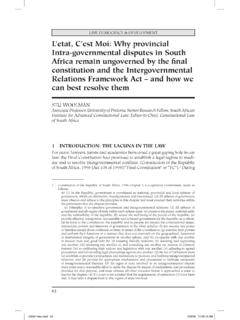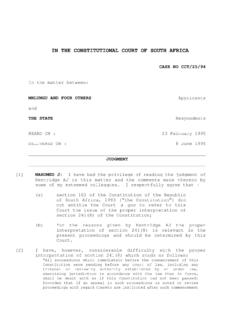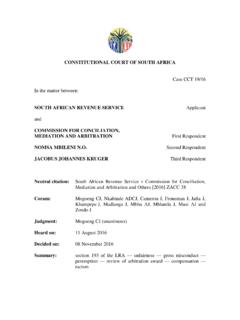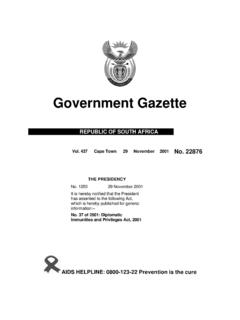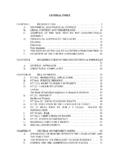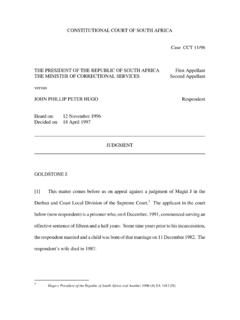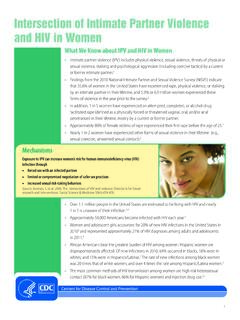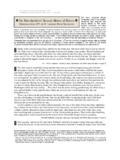Transcription of CONSTITUTIONAL COURT OF SOUTH AFRICA THE TEDDY …
1 CONSTITUTIONAL COURT OF SOUTH AFRICA Case CCT 12/13 [2013] ZACC 35 In the matter between: THE TEDDY bear clinic FOR abused children First Applicant RAPCAN Second Applicant and MINISTER OF JUSTICE AND CONSTITUTIONAL DEVELOPMENT First Respondent NATIONAL DIRECTOR OF PUBLIC PROSECUTIONS Second Respondent and JUSTICE ALLIANCE OF SOUTH AFRICA First Amicus Curiae TRUSTEES FOR THE TIME BEING OF THE WOMEN S LEGAL CENTRE TRUST Second Amicus Curiae TSHWARANANG LEGAL ADVOCACY CENTRE Third Amicus Curiae Heard on : 30 May 2013 Decided on : 3 October 2013 JUDGMENT KHAMPEPE J 2 KHAMPEPE J (Mogoeng CJ, Bosielo AJ, Froneman J, Jafta J, Mhlantla AJ, Nkabinde J, Skweyiya J and Zondo J concurring): Introduction [1] children are precious members of our society and any law that affects them must have due regard to their vulnerability and their need for guidance. We have a duty to ensure that they receive the support and assistance that is necessary for their positive growth and development.
2 Indeed, this COURT has recognised that children merit special protection through legislation that guards and enforces their rights and We must be careful, however, to ensure that, in attempting to guide and protect children , our interventions do not expose them to harsh circumstances which can only have adverse effects on their development. [2] This is an application for confirmation of a ruling by the North Gauteng High COURT , Pretoria (High COURT ) that certain provisions of the Criminal Law (Sexual Offences and Related Matters) Amendment Act2 relating to the criminalisation of consensual sexual conduct with children of a certain age, are constitutionally invalid. In terms of section 172(2)(a) of the Constitution, the High COURT s ruling has no force unless and until confirmed by this COURT . [3] At the outset it is important to emphasise what this case is not about.
3 It is not about whether children should or should not engage in sexual conduct. It is also not 1 De Reuck v Director of Public Prosecutions, Witwatersrand Local Division, and Others [2003] ZACC 19; 2004 (1) SA 406 (CC); 2003 (12) BCLR 1333 (CC) at para 63. 2 32 of 2007 (Sexual Offences Act). KHAMPEPE J 3 about whether Parliament may set a minimum age for consensual sexual conduct. Rather, we are concerned with a far narrower issue: whether it is constitutionally permissible for children to be subject to criminal sanctions in order to deter early sexual intimacy and combat the risks associated therewith. Parties [4] The first applicant is The TEDDY bear clinic for abused children , a not-for-profit company that provides a wide range of medical and related services to abused children and coordinates programmes to divert young sex offenders from the criminal justice system.
4 [5] The second applicant, likewise a not-for-profit company, is RAPCAN, an acronym for Resources Aimed at the Prevention of Child Abuse and Neglect . It is dedicated to the prevention of child victimisation and the promotion of children s rights, which it does by, amongst other things, developing best practices in relation to child victims and witnesses in the criminal justice system and by advocating legal and policy reforms to protect children from abuse, exploitation and neglect. [6] Both applicants have over twenty years experience in attempting to curb the scourge of sexual abuse of children , and in dealing with its consequences. [7] The first respondent is the Minister of Justice and CONSTITUTIONAL Development (Minister), cited in his capacity as the Minister responsible for the administration of KHAMPEPE J 4 the Sexual Offences Act. The second respondent is the National Director of Public Prosecutions (NDPP), cited because of the powers and obligations conferred on that office by the Sexual Offences Act.
5 [8] The first amicus is the Justice Alliance of SOUTH AFRICA (JASA). JASA has an interest in this matter by virtue of its aim to uphold and develop Judeo-Christian values, the Constitution and the law of SOUTH AFRICA by means of litigation. [9] The Women s Legal Centre Trust and the Tshwaranang Legal Advocacy Centre were admitted to make joint submissions as the second and third amici. Both organisations were established in order to advance the human rights of women in SOUTH AFRICA . The scheme of the Sexual Offences Act [10] The Act, in force with effect from 16 December 2007, represents a comprehensive legislative reform of both statutory and common-law criminal liability in relation to the commission of sexual offences. As set out in the introductory text of the statute, its purpose is to comprehensively and extensively review and amend all aspects of the laws and the implementation of the laws relating to sexual offences, and to deal with all legal aspects of or relating to sexual offences in a single statute, [including] by.
6 Enacting comprehensive provisions dealing with the creation of certain new, expanded or amended sexual offences against children and persons who are mentally disabled .. despite some of the offences being similar to offences created in respect of adults as the creation of these offences aims to address the particular vulnerability of children KHAMPEPE J 5 and persons who are mentally disabled in respect of sexual abuse or exploitation; eliminating the differentiation drawn between the age of consent for different consensual sexual acts and providing for special provisions relating to the prosecution and adjudication of consensual sexual acts between children older than 12 years but younger than 16 years; .. [and] creating a duty to report sexual offences committed with or against children or persons who are mentally disabled . [11] This case is primarily concerned with Part 1 of Chapter 3 of the Sexual Offences Act, which criminalises the performance of certain consensual sexual acts (by adults and children ) with children who are between 12- and 16-years old (adolescents).
7 3 Section 15 deals with the offence of statutory rape : Acts of consensual sexual penetration with certain children (statutory rape) 15 (1) A person ( A ) who commits an act of sexual penetration with a child ( B ) is, despite the consent of B to the commission of such an act, guilty of the offence of having committed an act of consensual sexual penetration with a child. (2) (a) The institution of a prosecution for an offence referred to in subsection (1) must be authorised in writing by the National Director of Public Prosecutions if both A and B were children at the time of the alleged commission of the offence: Provided that, in the event that the National Director of Public Prosecutions authorises the institution of a prosecution, both A and B must be charged with contravening subsection (1). (b) The National Director of Public Prosecutions may not delegate his or her power to decide whether a prosecution in terms of this section should be instituted or not.
8 [12] The Act gives the term sexual penetration a wide definition, including 3 It is important to note that the commission of non-consensual sexual offences, including rape and sexual assault, whether committed by adults or children , is dealt with by Parts 1 and 2 of Chapter 2. The criminalisation of such conduct is not under challenge in these proceedings. KHAMPEPE J 6 any act which causes penetration to any extent whatsoever by (a) the genital organs of one person into or beyond the genital organs, anus, or mouth of another person; (b) any other part of the body of one person or, any object, including any part of the body of an animal, into or beyond the genital organs or anus of another person; or (c) the genital organs of an animal, into or beyond the mouth of another person . [13] Section 16 of the Act imposes criminal liability for committing statutory sexual assault : Acts of consensual sexual violation with certain children (statutory sexual assault) 16 (1) A person ( A ) who commits an act of sexual violation with a child ( B ) is, despite the consent of B to the commission of such an act, guilty of the offence of having committed an act of consensual sexual violation with a child.
9 (2) (a) The institution of a prosecution for an offence referred to in subsection (1) must be authorised in writing by the relevant Director of Public Prosecutions if both A and B were children at the time of the alleged commission of the offence: Provided that, in the event that the Director of Public Prosecutions concerned authorises the institution of a prosecution, both A and B must be charged with contravening subsection (1). (b) The Director of Public Prosecutions concerned may not delegate his or her power to decide whether a prosecution in terms of this section should be instituted or not. [14] The Act in turn defines sexual violation in very broad terms to include any act which causes (a) direct or indirect contact between the KHAMPEPE J 7 (i) genital organs or anus of one person or, in the case of a female, her breasts, and any part of the body of another person or an animal, or any object, including any object resembling or representing the genital organs or anus of a person or an animal; (ii) mouth of one person and (aa) the genital organs or anus of another person or, in the case of a female, her breasts; (bb) the mouth of another person; (cc) any other part of the body of another person, other than the genital organs or anus of that person or, in the case of a female, her breasts, which could (aaa) be used in an act of sexual penetration; (bbb) cause sexual arousal or stimulation.
10 Or (ccc) be sexually aroused or stimulated thereby; or (dd) any object resembling the genital organs or anus of a person, and in the case of a female, her breasts, or an animal; or (iii) mouth of the complainant and the genital organs or anus of an animal; (b) the masturbation of one person by another person; or (c) the insertion of any object resembling or representing the genital organs of a person or animal, into or beyond the mouth of another person, but does not include an act of sexual penetration . [15] Although in terms of the Constitution,4 and in relation to most provisions of the Act, a child is any person under the age of 18 years, for the purposes of sections 15 and 16 of the Sexual Offences Act a child is defined as a person 12 years or older but under the age of 16 years .5 In other words, statutory rape or statutory sexual assault can only be perpetrated against a child between the ages of 12 and 15 years (inclusive).
